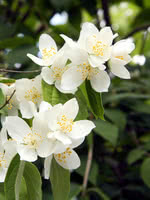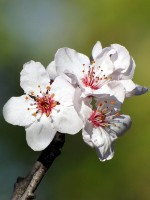Mon-Fri 9am - 5pm Mountain time
Western Sand Cherry vs Mock Orange
Philadelphus coronarius
Prunus pumila var besseyi
NOT AVAILABLE THIS SEASON - MIGHT RETURN
NOT AVAILABLE THIS SEASON - MIGHT RETURN
Mock Orange is an ornamental shrub known for its fragrant, white flowers. The scent is often described as orange-like with a hint of jasmine. Attractive to pollinators, hummingbirds, and humans alike.
Mock Orange is highly versatile, and can be used as an ornamental shrub, either alone or as a hedge. It is well suited for streambank stabilization and riparian zone restoration, due to its ability to grow in low, moist areas as well as those that are high and dry. Lewis Mock Orange also has the capability of being used in soil bioengineering projects such as live staking.
Western Sand Cherry is known for its unique, leathery grey-green foliage and beautiful white blossoms. It is a popular ornamental shrub in parks and front yards. Both you and the wildlife will love its edible small dark red to purple cherries.
Due to its small stature and spreading qualities, Western Sandcherry is suitable as an underplanting or groundcover.
Many people graft plum and cherry varieties to Western Sand Cherry and use it as rootstock. It is also popular to graft hardy apricots to.

